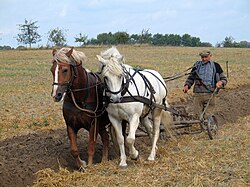Wikijunior:How Things Work/Wedge
Who invented it?
[edit | edit source]
The origin of the wedge is unknown, because it has been in use from as early as the stone age. The first wedge was probably used as a knife or scraper and was probably just a broken piece of a stone. Stones that fit easily in your hand and are sharp enough to cut meat, grass and bark are not hard to find. You can find pieces of stone that can be used as a knife just lying on the ground in some places.
The wedge is one of the very first inventions of humans. The wedge is one of the six simple machines and may have been the first or second developed (along with the Lever. When early humans made scrapers, axes and knives from stone, they were making a wedge. The earliest known wedges made by people were made 2.6 million years ago. Simple stone tools like these are called "Oldowan" tools by archaeologists.
In ancient Egyptian quarries, bronze wedges were used to break away blocks of stone used in construction. Wooden wedges, that swelled after being saturated with water, were also used. Some indigenous peoples of the Americas used antler wedges for splitting and working wood to make canoes, dwellings and other objects.


A wedge is a triangular shaped tool that is thicker on one end (the blunt end) and thinner on the other end (the edge.) A slice of pie is the shape of a wedge. Wedges are one of the six simple machines. It can be used to separate two objects, split an object, lift an object, or hold an object in place.
How does it get power?
[edit | edit source]Its power comes from outside forces acting on it. A wedge converts a force applied to its blunt end into forces perpendicular (at a right angle) to its inclined surfaces. A short wedge with a wide angle may do a job faster, but it requires more force than a long wedge with a narrow angle.
How dangerous is it?
[edit | edit source]Because a wedge is thin on the edge, it is sharp. There are many wedges you have to be careful with, like knives and scissors. However, some wedges can be blunt and not dangerous at all...
How does it vary?
[edit | edit source]Some wedges are used to separate. Common examples of this type of wedge include knives, axes, nails, scissors, and plows (British English: ploughs). Others are used to lift things or adjust the distance between them. A long tapered piece of wood called a shim is used in carpentry to make fine adjustments. Still other wedges are used to hold things in place. A doorstop is an example of this kind of wedge.

How has it changed the world?
[edit | edit source]The wedge might be the most important invention in human history. Without wedges, we would not have been able to cut wood, hunt animals, or make clothing. A particular kind of wedge called the plow allowed human beings to farm the land.
What idea(s) and/or inventions had to be developed before it could be created?
[edit | edit source]The only thing that people had to know was how to chip rock to make it sharp. Now we usually use metal for most wedges.
